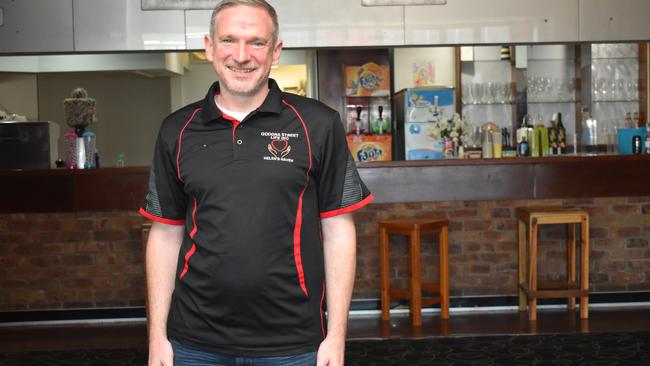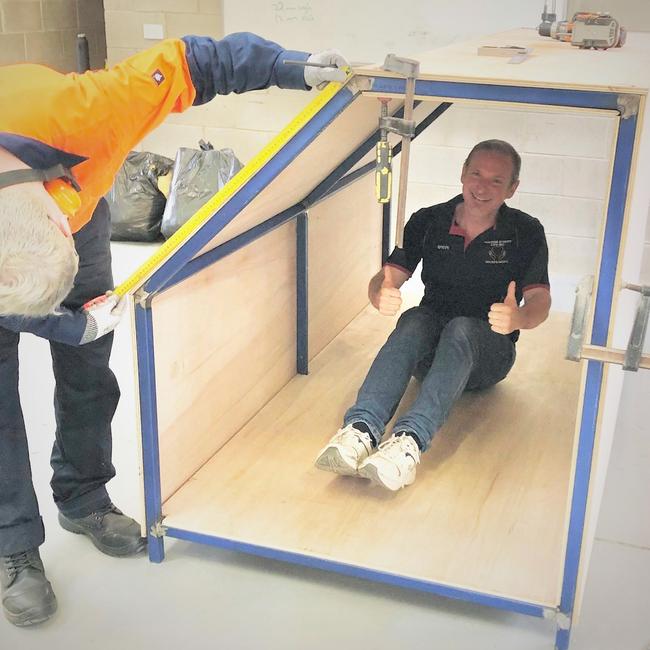Sleeping pods revolutionising Australia’s housing crisis
It’s no bigger than your kid’s bed, but it’s a world of change for Australia’s homeless.
Home
Don't miss out on the headlines from Home. Followed categories will be added to My News.
This Queensland community organisation is tackling homelessness with Japanese-style “pod” housing.
Founded by Helen Youngberry in 2018 and developed over three years, the Goodna Street Life sleeping pods are designed to provide temporary crisis housing for people and families facing homelessness.
Each pod is slightly bigger than a single size mattress, made of aluminium and lightweight, weatherproof MDF with doors that lock and a window that slides open for fresh air.
Powered by solar panels, the pods also feature USB chargers, functional lights and includes a mattress and bedding.


But what makes the pods effective temporary housing is that Goodna Street Life gives tenants individualised consultation to ensure a pathway to permanent housing.
“(The pods) aren’t solutions to homelessness in the broad term, they’re temporary solutions to combat rough sleeping,” vice president Steven Purcell told news.com.au.
“To address that first initial stage with someone – whether it be a family breakdown, domestic violence or abuse, whether it be just being evicted from a property after hours, or in a share house of someone that was staying in an unsafe space already – if they find themselves homeless after hours, they don’t have to go and find a park to sleep in.
“They can come to us and they can have a secure bed for the night and then in the morning we can help them with a meal and some support services to start to identify what happened, what’s the situation and what’s the best way to actually resolve homelessness for this particular person.”
Homelessness on the rise
With almost 20,000 people facing homelessness in Queensland, and approximately 290,000 people facing homelessness nationwide – the number is only expected to rise.

After the pandemic changed the world’s economy, recent flooding displaced thousands across the eastern coast of Australia, and interest rates rose – the amount of people who found themselves homeless for the first time surged.
Since the services launched, Goodna Street Life has set up six pods in an area dubbed Helen’s Haven, but faced up to 15 calls a day and demand for their services tripled – they’re looking to set up eight more pods.
“We’re getting more and more families or people calling us to say that my landlord has increased the rent, or they’re selling the property and they’ve given me notice to leave and I still haven’t found anywhere to go,” Mr Purcell said.
“At the same time warehousing people that were in that situation 12 months ago and are still sleeping in their cars because they’ve got nowhere to go – I’m talking about families with children.”
Grit. Spit. And a whole lotta red tape
Providing access to temporary housing isn’t a revolutionary idea when it come to addressing homelessness.

But what sets the Goodna Street Life apart from most other services – including Government programs and services – is how well co-ordinated the effort is.
Mr Purcell said with how “fractured” the current system is, complex homelessness cases often “fall through the cracks”.
On top of that, bureaucratic processes such as a focus on meeting KPI’s, meeting quotas, and lengthy application process meant that for people facing the immediate threat of homelessness could find themselves on the streets for weeks before an appointment to address their situation could be made.
“We have so many stories of us trying to provide support for people by calling Youth Services and they tell us they only have a bed for an 18 year old male – so they have to fit into this specific category in order to access a bed because that’s what the service is funded for,” he added.
“So the real problem with the current format is that public housing is so restrictive and they don’t have the flexibility to actually deal with crisis.”
“But Helen and I and the team here – we’re the decision makers for the organisation where the people that are making the beds, we’re cleaning the toilets, we’re providing the counselling support, were directly in contact with the people that need help every single day so we’re able to react and respond to crisis,” he added.
Australia’s most vulnerable left to face the streets
Mr Purcell said that Australia’s housing system was failing the “most vulnerable” people.

While the true success of the temporary pod housing system lies in its capacity to provide targeted counselling, Mr Purcell said it also highlighted the depth of how homelessness can ravage people.
He recalled how a woman spoke to him after they managed to transition her from Family Crisis Accommodation to permanent housing, confessing she previously contemplated suicide after facing homelessness.
“She felt that she failed her children that she couldn’t get any help and that she was going to be on the street with her children – her nine month old baby and two kids with special needs, non-verbal autism – living in a garage, and then the next step was to be on the street,” he said.
“It was devastating for her to be in that situation … but then she stayed with us in emergency housing for a week.”
“One of the things I think is most jarring and difficult for me to comprehend is how this can happen in a country like ours – that is so wealthy and lucky and fortunate and we do a lot of great things to be proud of.
“But the housing system has really failed the most vulnerable people who are really pushed out of the private housing market – it’s the single mums trying to care for children with high needs the kids with disabilities and whether that be physical or intellectual, psychosocial disabilities; the elderly … and people with complex mental health issues.”
More support needed for pod housing
As Australia’s housing crisis worsens, Mr Purcell said they were hopeful to expand their services not just within the Sunshine State, but across the country.

“We’ve been seeking to find opportunities to partner with other organisations that can replicate our model,” he said.
“We can provide all of our systems and our processes and the intellectual property of what we do and how we do it to other organisations that can act in this immediate crisis response mode to provide that additional housing.”
But while the Goodna Street Life organisation are keen to share their methods and services, Mr Purcell said the heart of any expansion had to prioritise the individual safety of those facing homelessness rather than an opportunity to capitalise on the situation.
“There’s a there’s a really high risk in any of these spaces for safety and this is where I think why there is a lot of red tape and sometimes that red tape is necessary right to create safety,” he added.
“So we have to be really creative and really flexible and we do rely heavily on community support and donations from the private sector to help us keep going, so it would be great if we did have like more land more houses or opportunities to create spaces.”
More Coverage
Originally published as Sleeping pods revolutionising Australia’s housing crisis




